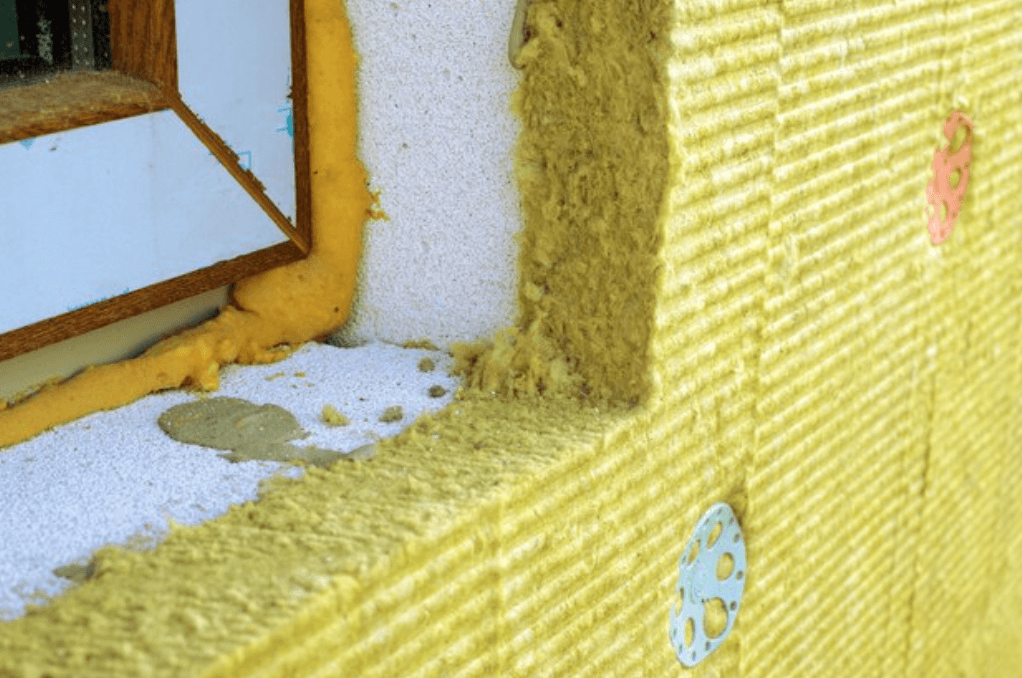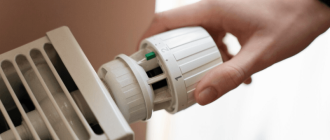If you’re considering insulating your home, you may be wondering what you need to know about blown-in foam insulation. This popular method of insulation offers many benefits, including energy savings and increased comfort. But one key factor to consider when choosing blown-in foam insulation is its R-value.
The R-value is a measure of how well a material can resist heat flow. In simple terms, the higher the R-value, the better the insulation. Blown-in foam insulation typically has a higher R-value compared to other insulation materials, making it a cost-effective choice for homeowners.
When choosing blown-in foam insulation, it’s important to consider factors such as the climate in your area and your home’s specific needs. The R-value of the insulation will determine its effectiveness in keeping your home warm in the winter and cool in the summer. Therefore, it’s crucial to choose the right R-value for your home to ensure optimal energy efficiency and comfort.
Blown-In Foam Insulation: A Comprehensive Guide
When it comes to insulating your home, blown-in foam insulation is a popular choice. It offers excellent thermal performance and can help reduce your energy costs. But before you jump in and start the installation process, there are a few key things you need to know about blown-in foam insulation and its R-value.
What is Blown-In Foam Insulation?
Blown-in foam insulation refers to a type of insulation material that is installed using a blowing machine. It is composed of expanding foam, which is sprayed into the desired area. The foam expands and hardens, creating a barrier that helps to prevent the transfer of heat and cold.
Blown-in foam insulation is commonly used in attics, walls, and crawl spaces. It can be especially effective in areas with irregular shapes or hard-to-reach spaces, as it can easily conform to the contours of the area.
The Importance of R-Value
When choosing insulation, understanding the R-value is crucial. R-value refers to the insulation material’s thermal resistance, or its ability to resist heat flow. The higher the R-value, the more effective the insulation is at preventing heat transfer.
Blown-in foam insulation typically has a high R-value, making it an excellent choice for homeowners who want to maximize energy efficiency. It can help keep your home cooler in the summer and warmer in the winter, reducing the need for excessive heating or cooling.
Additionally, the R-value of blown-in foam insulation can be customized based on your specific needs. A professional installer can adjust the thickness and density of the foam to achieve the desired level of insulation.
What You Need to Know
Before installing blown-in foam insulation, it’s important to consider a few key factors. First, you should ensure that your home is properly sealed to prevent air leakage, as this can reduce the effectiveness of the insulation.
It’s also essential to hire a professional installer who has experience with blown-in foam insulation. They will have the necessary equipment and expertise to ensure a proper installation.
Lastly, blown-in foam insulation requires some preparation before installation. This typically involves clearing the area of any debris or obstructions and making any necessary repairs or upgrades.
In conclusion, blown-in foam insulation is a highly effective option for insulating your home. By understanding its R-value and considering other important factors, you can make an informed decision and enjoy the benefits of improved energy efficiency and comfort in your home.
The Basics of Blown-In Foam Insulation
When it comes to insulation, it’s important to know what type will provide the most effective results for your home or building. Blown-in foam insulation is a popular choice for many because of its high insulating capabilities and versatility. In this article, we will explain the basics of blown-in foam insulation and why it’s the insulation you need.
What is blown-in foam insulation?
Blown-in foam insulation is a type of insulation that is sprayed or blown into walls, attics, and crawl spaces. It is made up of foam particles that are mixed with a blowing agent, which allows for expansion and creates a tightly sealed barrier. This type of insulation is known for its ability to fill in gaps and crevices, providing a complete coverage and reducing air leakage.
Why is the R-Value important?
The R-Value is a measurement of an insulating material’s resistance to heat flow. It is an important factor to consider when choosing insulation because it determines the insulation’s ability to keep heat in or out. The higher the R-Value, the better the insulation’s thermal performance. Blown-in foam insulation typically has a high R-Value, making it an effective choice for improving energy efficiency and reducing heating and cooling costs.
Blown-in foam insulation also offers other benefits such as soundproofing and moisture control. Its ability to create a tightly sealed barrier helps to prevent air and moisture from entering or escaping, reducing the likelihood of drafts, mold, and mildew.
What do you need to know?
Before choosing blown-in foam insulation for your home or building, there are a few important things to consider. First, it’s important to assess the condition of your current insulation and identify any areas that need additional insulation. Consulting with a professional insulation contractor can help you determine the best course of action.
Additionally, it’s important to consider the climate and location of your property. Different climates require different types and levels of insulation. Understanding the local building codes and regulations can also help ensure that your insulation meets the necessary standards.
In conclusion, blown-in foam insulation is a versatile and effective choice for improving the energy efficiency and comfort of your home or building. Its high R-Value and ability to fill gaps and crevices make it an ideal solution for reducing heating and cooling costs. By understanding the basics of blown-in foam insulation and considering the specific needs of your property, you can make an informed decision and enjoy the many benefits it provides.
Understanding R-Value in Insulation
When it comes to insulation, one important factor to know is the R-value. Whether you are considering blown-in foam insulation or any other type, understanding the R-value is essential to making informed decisions for your home’s energy efficiency.
The R-value measures the ability of an insulation material to resist heat flow. The higher the R-value, the better the insulation’s resistance to heat transfer. It is a crucial factor in determining the energy-saving potential of an insulation material.
When selecting insulation for your home, you need to consider your climate zone and the desired energy efficiency. This will determine the recommended R-value for your specific needs. It is important to understand that different areas of your home may require different insulation R-values, based on factors like walls, attic, or basement.
Blown-in foam insulation offers a high R-value, making it an excellent choice for homeowners looking to maximize energy efficiency. The foam is blown into the desired area, expanding and filling any gaps or voids present. This seamless installation provides an effective barrier against heat transfer.
Before investing in blown-in foam insulation or any other type, educate yourself about the R-value and how it relates to your specific insulation needs. By understanding the R-value, you can confidently choose the right insulation material to keep your home comfortable and energy-efficient.
Benefits of Blown-In Foam Insulation
When it comes to insulation, it’s important to know what options are available to you and what benefits they can provide. Blown-in foam insulation is a popular choice for many homeowners due to its numerous advantages.
One of the main benefits of blown-in foam insulation is its high R-value. The R-value measures an insulation material’s thermal resistance and its ability to prevent heat transfer. Blown-in foam insulation has a superior R-value compared to other types of insulation, meaning it provides better protection against heat loss or gain.
In addition to its exceptional R-value, blown-in foam insulation offers excellent air sealing properties. The foam expands and fills all the gaps and crevices in the walls, ceilings, and floors, creating a seamless barrier against air leakage. This not only improves the energy efficiency of your home but also enhances indoor air quality by preventing drafts and blocking out pollutants.
Another advantage of blown-in foam insulation is its versatility. It can be installed in various areas of your home, including the attic, walls, and crawl spaces. The foam can easily conform to any shape or size, ensuring a tight and effective seal in hard-to-reach places.
Furthermore, blown-in foam insulation is a durable and long-lasting solution. It does not settle or sag over time, maintaining its effectiveness and integrity. This means you won’t have to worry about replacing or re-insulating your home frequently.
Lastly, blown-in foam insulation is an eco-friendly option. It is made from environmentally-friendly materials and does not release harmful gases or toxins into the air. By choosing blown-in foam insulation, you can reduce your carbon footprint and contribute to a greener planet.
| Benefits of Blown-In Foam Insulation |
|---|
| High R-value |
| Excellent air sealing properties |
| Versatility in installation |
| Durable and long-lasting |
| Eco-friendly |
Factors Affecting R-Value in Blown-In Foam Insulation
Blown-in foam insulation is a popular choice for homeowners looking to increase energy efficiency and reduce heating and cooling costs. Understanding the R-value of the insulation you select is crucial in determining its effectiveness in insulating your home.
The R-value measures the thermal resistance of insulation, representing its ability to resist heat transfer. The higher the R-value, the better the insulation’s ability to prevent heat flow.
When considering blown-in foam insulation, there are several factors that can affect the final R-value you achieve:
- Type of foam: Different types of foam insulation have varying R-values. Closed-cell foam typically has a higher R-value than open-cell foam, as it is denser and provides better insulation.
- Thickness: The thickness of the foam layer can impact the R-value. A thicker layer of foam generally provides higher insulation and therefore a higher R-value.
- Installation technique: The method used to install the blown-in foam insulation can affect its R-value. Proper installation is essential to ensure the foam fills all gaps and voids, providing an airtight barrier against heat transfer.
- Moisture content: Moisture can decrease the effectiveness of foam insulation and reduce its R-value. Proper moisture management and ensuring the foam is not exposed to water or excessive humidity are critical in maintaining its insulating properties.
- Age and condition: Over time, foam insulation may deteriorate or settle, potentially reducing its R-value. Regular inspections and maintenance can help identify any issues and ensure the insulation remains effective.
Before deciding on blown-in foam insulation, it is essential to understand these factors and consult with a professional to determine the insulation type and thickness you need to achieve the desired R-value for your home. Additionally, following proper installation and maintenance guidelines will help maximize the insulation’s effectiveness and energy-saving benefits.
Blown-In Foam Insulation vs. Other Insulation Methods
If you’re considering insulating your home or commercial building, you need to know what the R-value is and why it’s important. The R-value measures the effectiveness of insulation in resisting heat transfer. A higher R-value means better insulation.
When it comes to insulation methods, blown-in foam insulation is a great option to consider. Blown-in foam insulation, also known as spray foam insulation, offers numerous advantages over other insulation methods.
1. Superior Insulation
One of the main benefits of blown-in foam insulation is its superior insulation properties. The foam expands and fills gaps, creating an airtight barrier that helps prevent heat loss or gain. This leads to reduced energy consumption and lower utility bills.
2. Versatility
Blown-in foam insulation can be applied to various surfaces, including walls, roofs, attics, and crawl spaces. It can also be used in new construction or retrofitted into existing structures, making it a versatile option for insulation projects.
Compared to other insulation methods like fiberglass batts or cellulose insulation, blown-in foam insulation provides better coverage and can easily reach areas that are difficult to access, such as small crevices or irregular shapes.
Overall, blown-in foam insulation offers superior insulation, versatility, and long-term energy savings. It’s important to consult with a professional insulation contractor to determine the best insulation method for your specific needs and budget.
How to Install Blown-In Foam Insulation
If you’re looking to insulate your home, blown-in foam insulation can be a great option. It provides excellent thermal performance, air sealing, moisture resistance, and soundproofing. Here’s what you need to know about installing blown-in foam insulation:
1. Determine the amount of insulation needed
Before starting the installation, you need to calculate the amount of blown-in foam insulation required. Measure the total square footage of the area to be insulated and consult with a professional to determine the appropriate R-value for your region.
2. Prepare the area
Prior to installation, make sure that the area is clean and free of any debris. Remove any objects that may obstruct the insulation process, such as furniture or appliances.
3. Wear the right protective gear
When working with blown-in foam insulation, it’s important to wear appropriate protective gear, including gloves, goggles, and a dust mask. This will protect you from any potential health hazards.
4. Install the blown-in foam insulation
Start by placing the insulation machine outside the house and connecting it to an appropriate power source. Enter the house with the hose and start spraying the foam insulation into the desired areas, moving in a consistent and systematic manner.
- Begin with the furthest corner of the room and gradually work your way towards the exit.
- Ensure that the foam is evenly distributed and fills all the gaps and crevices.
- Take breaks as needed to refill the machine with more foam insulation.
5. Clean up and inspect
Once the installation is complete, clean up any excess foam insulation that may have spilled or accumulated. Inspect the area to ensure that it has been properly insulated and there are no gaps or areas that may need additional foam.
Installing blown-in foam insulation can be a DIY project, but it’s important to consult with professionals to ensure proper insulation and safety. Following these steps will help you achieve an efficient and effective insulation job.
Common Issues with Blown-In Foam Insulation R-Value
When considering blown-in foam insulation for your home, understanding the R-value is essential. The R-value measures the insulation’s ability to resist heat flow. However, there are some common issues you should be aware of when it comes to the R-value of blown-in foam insulation.
1. Need for Understanding: It’s important to know what R-value you need for your specific location and climate. The R-value requirements can vary depending on factors such as the average temperature, humidity levels, and the heating and cooling systems used in your area.
2. What is R-Value: The R-value is a numerical representation of an insulation material’s thermal resistance. It indicates how well the material can resist heat flow. The higher the R-value, the better the insulation’s ability to resist heat transfer.
3. Blown-in foam insulation: Blown-in foam insulation is a popular choice for many homeowners due to its ability to fill gaps and crevices, providing a seamless insulation barrier. However, it’s important to note that the R-value of blown-in foam insulation can vary depending on the installation process and the type of foam used.
4. Insulation thickness: The thickness of the blown-in foam insulation can also affect the R-value. To achieve the desired R-value, a specific depth or thickness of foam insulation may be required. It’s crucial to ensure that the installation meets the recommended thickness for optimal energy efficiency.
5. Quality of installation: The quality of the installation plays a significant role in the R-value effectiveness of blown-in foam insulation. Proper installation techniques, such as ensuring consistent coverage and avoiding compression, are essential to maximize the insulation’s performance.
In conclusion, understanding the R-value and considering the common issues related to blown-in foam insulation is crucial for achieving optimal energy efficiency in your home. By taking into account factors such as the climate, installation process, and thickness, you can make informed decisions and ensure your home is properly insulated.
Tips for Maintaining the R-Value of Blown-In Foam Insulation
When it comes to blown-in foam insulation, the R-value is an important factor to consider. The R-value measures the insulation’s ability to resist heat flow, with a higher R-value indicating better insulation. To ensure that your blown-in foam insulation maintains its R-value and effectively insulates your space, there are a few key tips you need to know.
Understand What R-Value You Need
Before installing blown-in foam insulation, it’s essential to understand what R-value you need for your specific project. The required R-value will depend on factors such as climate, local building codes, and your desired level of insulation. Consulting with a professional can help you determine the appropriate R-value for your insulation needs.
Know the Insulation Properties of Blown-In Foam
Blown-in foam insulation, also known as loose-fill insulation, is made up of small foam particles that are blown into the desired space. It effectively fills in gaps and cavities, providing excellent insulation. However, it’s important to be aware that blown-in foam’s R-value can decrease over time due to settling or compaction. Knowing this, regular maintenance and inspections are necessary to ensure the insulation’s performance.
Regular Inspections and Maintenance
To maintain the R-value of blown-in foam insulation, it’s crucial to perform regular inspections. Inspect the insulation for any signs of settling, compaction, or moisture intrusion. Also, check for any gaps or voids that may have occurred during installation. Addressing these issues promptly can help prevent a decrease in the insulation’s effectiveness and maintain its R-value.
| Tip | Description |
|---|---|
| Seal Gaps and Voids | Periodically check for any gaps or voids in the blown-in foam insulation and seal them with appropriate sealants to enhance its efficiency. |
| Inspect for Moisture | Regularly inspect the insulation for signs of moisture intrusion, such as water stains or mold growth. Address any moisture issues promptly to prevent damage and maintain insulation performance. |
| Consider Professional Inspection | Engaging a professional insulation contractor for periodic inspections can help ensure that the blown-in foam insulation is properly maintained and its R-value is preserved. |
By following these tips and regularly maintaining your blown-in foam insulation, you can help ensure that it maintains its R-value and provides optimal insulation for your space. Consult with professionals in the field to get the best advice tailored to your specific insulation needs.
Blown-In Foam Insulation: A Cost-Effective Solution
If you are considering insulation options for your home, blown-in foam insulation is definitely something you need to know about. This type of insulation has become increasingly popular due to its numerous benefits and cost-effectiveness.
Firstly, let’s talk about what blown-in foam insulation actually is. It is a type of insulation material that is created by mixing liquid foam and a blowing agent. This mixture is then sprayed into the desired area using special equipment. The foam expands and hardens, creating a seamless layer of insulation.
One of the main advantages of blown-in foam insulation is its high R-value. R-value measures the insulation’s ability to resist heat flow, and the higher the R-value, the better the insulation. Blown-in foam insulation has a higher R-value compared to other insulation options, meaning it provides better thermal protection for your home.
Another benefit of blown-in foam insulation is its ability to fill in all the nooks and crannies of the wall or attic, creating a complete seal. This helps to eliminate air leakage and drafts, ensuring that your home remains comfortable and energy-efficient.
Furthermore, blown-in foam insulation is a cost-effective solution. While the upfront cost may be higher compared to other insulation materials, such as fiberglass, the long-term savings are significant. The high R-value and air-sealing properties of blown-in foam insulation result in lower energy bills, as your heating and cooling systems do not need to work as hard to maintain a comfortable temperature.
Additionally, blown-in foam insulation is a durable and long-lasting solution. Unlike other insulation materials that may settle or degrade over time, blown-in foam insulation maintains its effectiveness for many years, providing continuous energy savings.
In conclusion, if you are looking for a cost-effective insulation solution, blown-in foam insulation is a great option. Its high R-value, air-sealing properties, and long-term durability make it an excellent choice for homeowners. Consider adding blown-in foam insulation to your home to enjoy improved comfort, energy savings, and a more sustainable living environment.
Is Blown-In Foam Insulation Right for You?
When it comes to insulating your home, it’s important to know what type of insulation you need. Blown-in foam insulation offers numerous benefits and is a popular choice for many homeowners.
What is Blown-In Foam Insulation?
Blown-in foam insulation is a type of insulation that is made from foam materials. It is installed by using a special machine that blows the foam into the desired area, creating a seamless barrier against heat transfer.
Why Choose Blown-In Foam Insulation?
There are several reasons why blown-in foam insulation may be the right choice for you:
| R-Value | Blown-in foam insulation has a high R-value, which means it provides excellent thermal resistance. This helps keep your home warm in the winter and cool in the summer. |
| Energy Efficiency | With its high R-value and excellent air sealing properties, blown-in foam insulation can significantly improve the energy efficiency of your home. This can lead to lower heating and cooling costs. |
| No Gaps or Spaces | Unlike other types of insulation, blown-in foam insulation fills in all gaps and spaces, creating an airtight seal. This helps prevent drafts, moisture, and pests from entering your home. |
| No Settling or Shifting | Blown-in foam insulation does not settle or shift over time, ensuring long-lasting performance and maintaining its thermal resistance properties. |
Before deciding if blown-in foam insulation is right for you, it’s important to consider your home’s specific needs and consult with a professional insulation contractor. They can assess your home and recommend the best insulation solution for maximum energy efficiency and comfort.
In conclusion, blown-in foam insulation can be a great choice for homeowners looking to improve their home’s energy efficiency and comfort. Its high R-value, excellent air sealing properties, and ability to fill gaps and spaces make it an effective insulation option.
Question and answer:
What is blown-in foam insulation?
Blown-in foam insulation is a type of insulation material that is used to fill spaces or cavities in a building’s walls, floors, and ceilings. It is typically made from polyurethane or polyisocyanurate foam and is installed using specialized equipment that blows the insulation material into the desired area.
What is the R-value of blown-in foam insulation?
The R-value of blown-in foam insulation can vary depending on the specific type and thickness of the foam used. However, it is generally considered to have a higher R-value than other types of insulation, such as fiberglass or cellulose. The R-value measures the insulation material’s resistance to heat flow, with a higher R-value indicating better insulation performance.
Why is R-value important for insulation?
R-value is important for insulation because it helps determine the effectiveness of the insulation material in preventing heat transfer. A higher R-value means that the insulation is better at reducing the flow of heat through the building’s walls, floors, and ceilings, which can help improve energy efficiency and reduce heating and cooling costs.
How can blown-in foam insulation improve energy efficiency?
Blown-in foam insulation can improve energy efficiency by reducing heat transfer through the building’s walls, floors, and ceilings. Its high R-value helps create a thermal barrier that prevents hot or cold air from penetrating the insulation material and entering the building’s interior. This can help maintain a more consistent and comfortable indoor temperature, reducing the need for heating or cooling systems and saving energy.
Can blown-in foam insulation be used in existing buildings?
Yes, blown-in foam insulation can be used in existing buildings. It is a versatile insulation material that can be installed in various areas, including walls, attics, and crawl spaces. The insulation can be blown into existing wall cavities or added on top of existing insulation to improve the overall thermal performance of the building.
How does blown-in foam insulation work?
Blown-in foam insulation works by using a machine to spray a liquid foam insulation material into a space. The foam expands and hardens, creating an airtight and thermal barrier. It fills in gaps and cracks, providing excellent insulation and energy efficiency.
What is the R-value of blown-in foam insulation?
The R-value of blown-in foam insulation varies depending on the type and thickness of the foam used. Generally, it has an R-value ranging from 3.6 to 8 per inch. So, a thicker layer of foam will have a higher R-value, providing better insulation.







